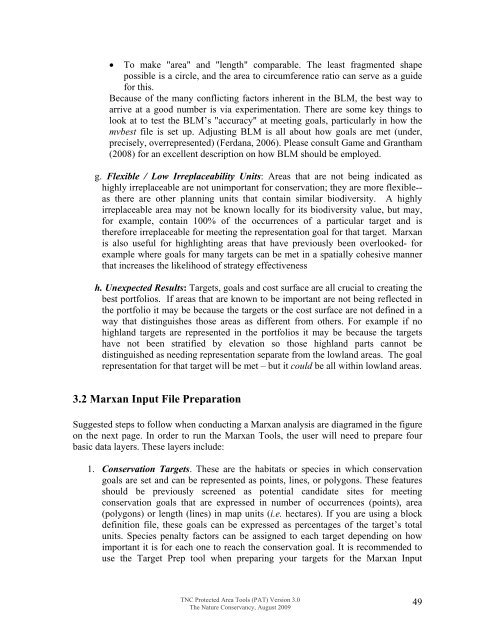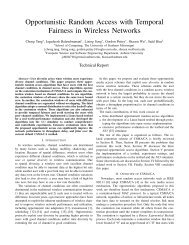Download the Tutorial
Download the Tutorial
Download the Tutorial
You also want an ePaper? Increase the reach of your titles
YUMPU automatically turns print PDFs into web optimized ePapers that Google loves.
• To make "area" and "length" comparable. The least fragmented shapepossible is a circle, and <strong>the</strong> area to circumference ratio can serve as a guidefor this.Because of <strong>the</strong> many conflicting factors inherent in <strong>the</strong> BLM, <strong>the</strong> best way toarrive at a good number is via experimentation. There are some key things tolook at to test <strong>the</strong> BLM’s "accuracy" at meeting goals, particularly in how <strong>the</strong>mvbest file is set up. Adjusting BLM is all about how goals are met (under,precisely, overrepresented) (Ferdana, 2006). Please consult Game and Grantham(2008) for an excellent description on how BLM should be employed.g. Flexible / Low Irreplaceability Units: Areas that are not being indicated ashighly irreplaceable are not unimportant for conservation; <strong>the</strong>y are more flexible--as <strong>the</strong>re are o<strong>the</strong>r planning units that contain similar biodiversity. A highlyirreplaceable area may not be known locally for its biodiversity value, but may,for example, contain 100% of <strong>the</strong> occurrences of a particular target and is<strong>the</strong>refore irreplaceable for meeting <strong>the</strong> representation goal for that target. Marxanis also useful for highlighting areas that have previously been overlooked- forexample where goals for many targets can be met in a spatially cohesive mannerthat increases <strong>the</strong> likelihood of strategy effectivenessh. Unexpected Results: Targets, goals and cost surface are all crucial to creating <strong>the</strong>best portfolios. If areas that are known to be important are not being reflected in<strong>the</strong> portfolio it may be because <strong>the</strong> targets or <strong>the</strong> cost surface are not defined in away that distinguishes those areas as different from o<strong>the</strong>rs. For example if nohighland targets are represented in <strong>the</strong> portfolios it may be because <strong>the</strong> targetshave not been stratified by elevation so those highland parts cannot bedistinguished as needing representation separate from <strong>the</strong> lowland areas. The goalrepresentation for that target will be met – but it could be all within lowland areas.3.2 Marxan Input File PreparationSuggested steps to follow when conducting a Marxan analysis are diagramed in <strong>the</strong> figureon <strong>the</strong> next page. In order to run <strong>the</strong> Marxan Tools, <strong>the</strong> user will need to prepare fourbasic data layers. These layers include:1. Conservation Targets. These are <strong>the</strong> habitats or species in which conservationgoals are set and can be represented as points, lines, or polygons. These featuresshould be previously screened as potential candidate sites for meetingconservation goals that are expressed in number of occurrences (points), area(polygons) or length (lines) in map units (i.e. hectares). If you are using a blockdefinition file, <strong>the</strong>se goals can be expressed as percentages of <strong>the</strong> target’s totalun its . Species penalty factors can be assigned to each target depending on howimportant it is for each one to reach <strong>the</strong> conservation goal. It is recommended touse <strong>the</strong> Target Prep tool when preparing your targets for <strong>the</strong> Marxan InputTNC Protected Area Tools (PAT) Version 3.0The Nature Conservancy, August 200949
















